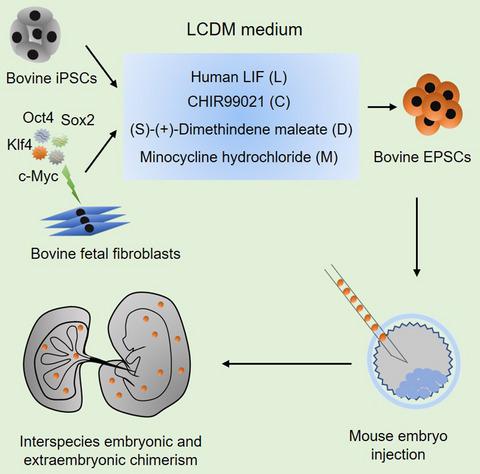Our official English website, www.x-mol.net, welcomes your
feedback! (Note: you will need to create a separate account there.)
LCDM medium supports the derivation of bovine extended pluripotent stem cells with embryonic and extraembryonic potency in bovine–mouse chimeras from iPSCs and bovine fetal fibroblasts
The FEBS Journal ( IF 5.5 ) Pub Date : 2021-02-01 , DOI: 10.1111/febs.15744 Jinzhu Xiang 1 , Hanning Wang 1 , Yuanyuan Zhang 1 , Jing Wang 1 , Fang Liu 1 , Xuejie Han 1 , Zhenyu Lu 1 , Chen Li 1 , Zihong Li 1 , Yanru Gao 1 , Yujing Tian 1 , Yingjie Wang 1 , Xueling Li 1
The FEBS Journal ( IF 5.5 ) Pub Date : 2021-02-01 , DOI: 10.1111/febs.15744 Jinzhu Xiang 1 , Hanning Wang 1 , Yuanyuan Zhang 1 , Jing Wang 1 , Fang Liu 1 , Xuejie Han 1 , Zhenyu Lu 1 , Chen Li 1 , Zihong Li 1 , Yanru Gao 1 , Yujing Tian 1 , Yingjie Wang 1 , Xueling Li 1
Affiliation

|
Cattle have emerged as one of the most important domestic animals widely used for meat, milk, and fur. Derivation of bovine pluripotent stem cells (PSCs) can be applied in drug selecting and human disease modeling and facilitated agriculture-related applications such as production of genetically excellent cattle by gene editing. Extended PSCs (EPSCs), capable of differentiating into embryonic and extraembryonic parts, have been generated in mouse, human, and pig. Whether bovine EPSCs could be generated, and their chimeric competency remains unclear. This study focused on derivation of bovine EPSCs using LCDM medium and exploring the characteristics of EPSCs among different species, including bovine, mouse, and human EPSCs. Here, using LCDM medium (consisting of hLIF, CHIR99021, (S)-(+)-dimethindene maleate, and minocycline hydrochloride) enables the derivation of bovine EPSCs from induced PSCs (iPSCs) and bovine fetal fibroblasts (BFF) with stable morphology, pluripotent marker expression, and in vitro differentiation ability. Notably, bovine EPSCs exhibited interspecies chimeric contribution to embryonic and extraembryonic tissues in pre-implantation blastocysts and postimplantation bovine–mouse chimeras. Transcriptome analysis revealed the unique molecular characteristics of bovine EPSCs compared with iPSCs. The similarities and differences in molecular features across bovine, human, and mouse EPSCs were also described by transcriptome analysis. Taken together, the LCDM culture system containing chemical cocktails can be used for the establishment and long-term passaging of bovine EPSCs with embryonic and extraembryonic potency in bovine–mouse chimeras. Our findings lay the foundation of generating PSCs in domestic animals and open avenues for basic and applied research in biology, medicine, and agriculture.
中文翻译:

LCDM 培养基支持从 iPSC 和牛胎儿成纤维细胞衍生牛 - 小鼠嵌合体中具有胚胎和胚胎外效力的牛扩展多能干细胞
牛已成为最重要的家畜之一,广泛用于肉类、牛奶和毛皮。牛多能干细胞 (PSC) 的衍生可用于药物选择和人类疾病建模,并促进与农业相关的应用,例如通过基因编辑生产遗传优良的牛。能够分化为胚胎和胚胎外部分的扩展 PSC (EPSC) 已在小鼠、人类和猪中产生。是否可以产生牛 EPSCs,以及它们的嵌合能力仍不清楚。本研究侧重于使用 LCDM 培养基衍生牛 EPSC,并探索不同物种(包括牛、小鼠和人 EPSC)中 EPSC 的特征。在这里,使用 LCDM 培养基(由 hLIF、CHIR99021、(S)-(+)-dimethindenemaleate、体外分化能力。值得注意的是,牛 EPSCs 对植入前囊胚和植入后牛 - 小鼠嵌合体中的胚胎和胚外组织表现出种间嵌合贡献。转录组分析揭示了与 iPSCs 相比,牛 EPSCs 的独特分子特征。转录组分析还描述了牛、人和小鼠 EPSC 在分子特征上的异同。总之,包含化学混合物的 LCDM 培养系统可用于在牛 - 小鼠嵌合体中建立和长期传代具有胚胎和胚胎外效力的牛 EPSC。我们的研究结果为在家养动物中产生 PSC 奠定了基础,并为生物学、医学和农业的基础和应用研究开辟了道路。
更新日期:2021-02-01
中文翻译:

LCDM 培养基支持从 iPSC 和牛胎儿成纤维细胞衍生牛 - 小鼠嵌合体中具有胚胎和胚胎外效力的牛扩展多能干细胞
牛已成为最重要的家畜之一,广泛用于肉类、牛奶和毛皮。牛多能干细胞 (PSC) 的衍生可用于药物选择和人类疾病建模,并促进与农业相关的应用,例如通过基因编辑生产遗传优良的牛。能够分化为胚胎和胚胎外部分的扩展 PSC (EPSC) 已在小鼠、人类和猪中产生。是否可以产生牛 EPSCs,以及它们的嵌合能力仍不清楚。本研究侧重于使用 LCDM 培养基衍生牛 EPSC,并探索不同物种(包括牛、小鼠和人 EPSC)中 EPSC 的特征。在这里,使用 LCDM 培养基(由 hLIF、CHIR99021、(S)-(+)-dimethindenemaleate、体外分化能力。值得注意的是,牛 EPSCs 对植入前囊胚和植入后牛 - 小鼠嵌合体中的胚胎和胚外组织表现出种间嵌合贡献。转录组分析揭示了与 iPSCs 相比,牛 EPSCs 的独特分子特征。转录组分析还描述了牛、人和小鼠 EPSC 在分子特征上的异同。总之,包含化学混合物的 LCDM 培养系统可用于在牛 - 小鼠嵌合体中建立和长期传代具有胚胎和胚胎外效力的牛 EPSC。我们的研究结果为在家养动物中产生 PSC 奠定了基础,并为生物学、医学和农业的基础和应用研究开辟了道路。











































 京公网安备 11010802027423号
京公网安备 11010802027423号